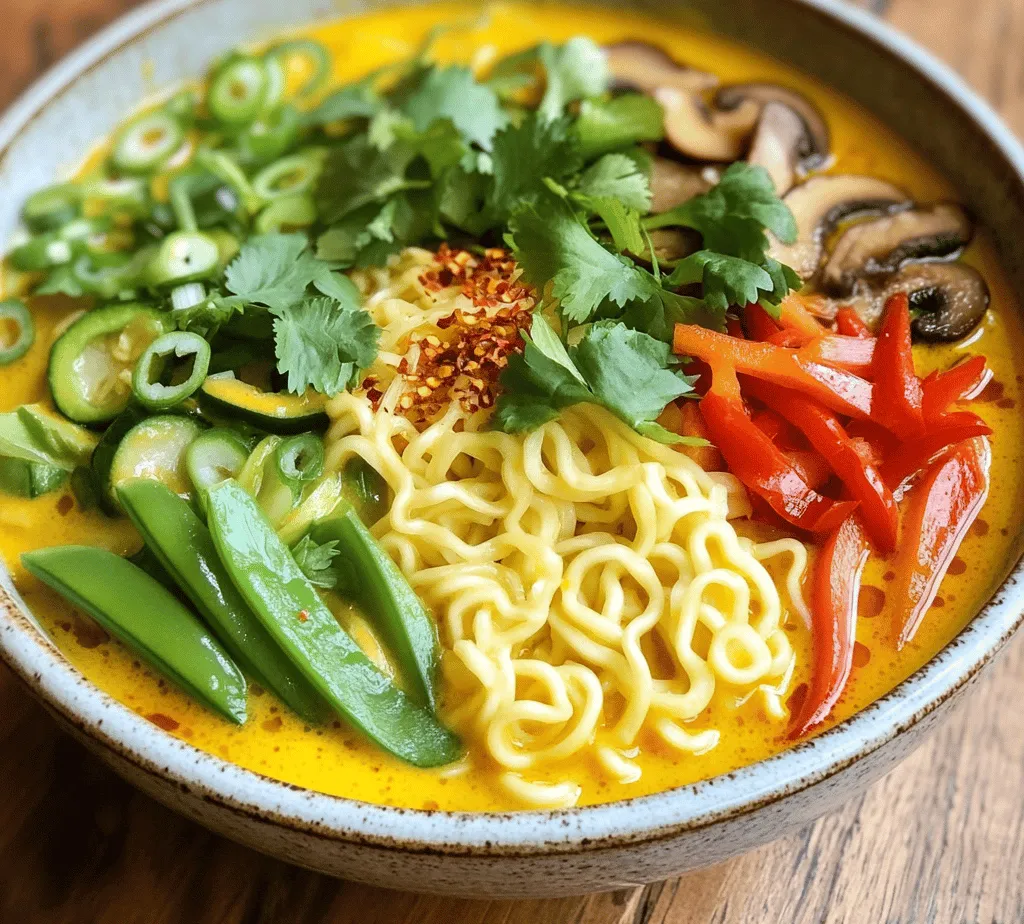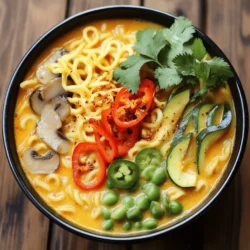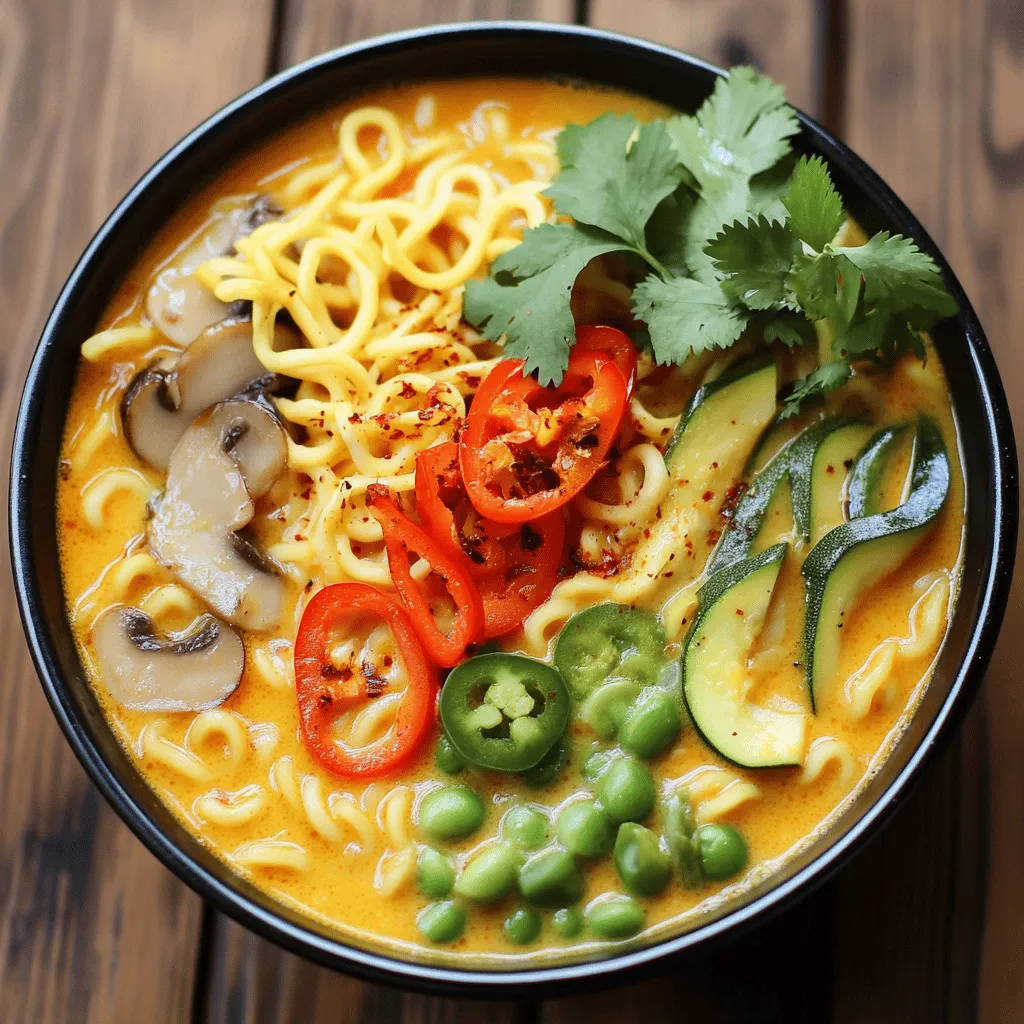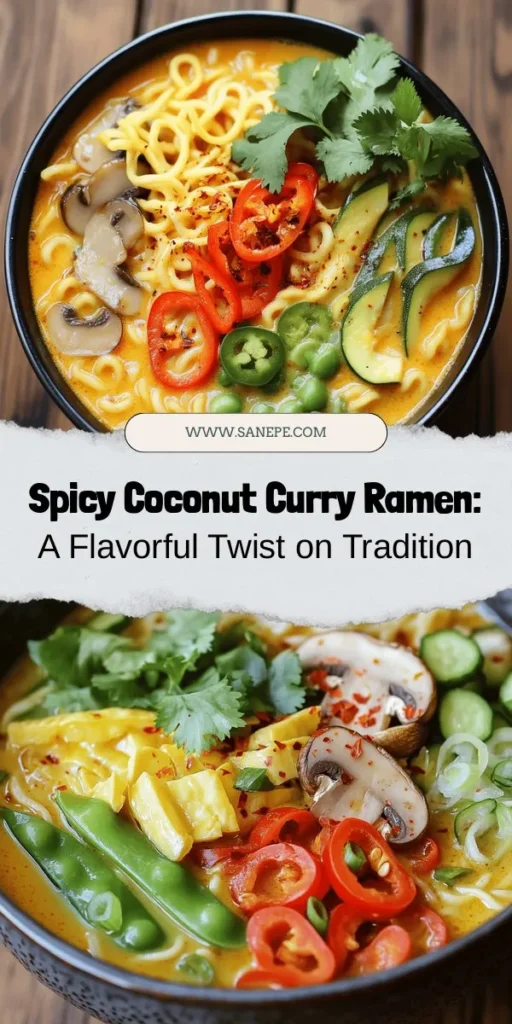Introduction
Ramen has long been a beloved staple in many cultures, celebrated for its comforting and versatile nature. This iconic Japanese dish comes in countless variations, each showcasing unique flavors and ingredients. In recent years, innovative chefs and home cooks alike have begun to experiment with ramen, merging traditional elements with exciting new profiles. One such delightful fusion is the Spicy Coconut Curry Ramen. This dish harmoniously blends the rich, creamy notes of coconut curry with the unmistakable umami depth of ramen, creating a culinary experience that is both satisfying and exhilarating.
The concept of combining coconut curry with ramen might seem unusual at first, but it is a pairing that brings out the best in both worlds. Coconut curry, with its fragrant spices and rich texture, perfectly complements the chewy noodles, making each bite a delightful adventure. Not only is this dish bursting with flavor, but it also boasts numerous health benefits. The incorporation of fresh vegetables, aromatic herbs, and nutrient-rich ingredients makes Spicy Coconut Curry Ramen a nourishing alternative to traditional ramen dishes. Whether you’re seeking a cozy meal to warm your soul or a vibrant dish to impress your dinner guests, this recipe is sure to satisfy.
The Fusion of Flavors: What Makes Spicy Coconut Curry Ramen Unique
At the heart of Spicy Coconut Curry Ramen lies the creative use of ingredients that come together to create a wonderfully layered flavor profile. Each component has a role, working in harmony to create a dish that is both comforting and invigorating.
The star of this dish is undoubtedly the red curry paste, which introduces a delightful heat and complexity to the broth. Made from a blend of chili peppers, garlic, lemongrass, and other spices, red curry paste is a staple in Thai cuisine and lends its vibrant flavor to the ramen. When combined with creamy coconut milk, the spiciness is beautifully balanced, resulting in a rich, velvety texture that envelops each noodle.
Coconut milk not only adds creaminess but also provides a subtle sweetness that counteracts the heat from the curry paste. This unique interplay between spiciness and creaminess creates a comforting warmth that lingers on the palate.
Moreover, the dish can easily cater to various dietary preferences. With a few adjustments, Spicy Coconut Curry Ramen can be made vegetarian or vegan by omitting fish sauce and using plant-based alternatives. For those who are gluten-sensitive, gluten-free ramen noodles can be substituted without sacrificing flavor or texture. This versatility ensures that everyone can enjoy a hearty bowl of ramen, regardless of dietary restrictions.
Understanding the Ingredients
To truly appreciate the beauty of Spicy Coconut Curry Ramen, it’s essential to understand the role of each ingredient in the recipe. Let’s dive into these components, exploring their flavors and health benefits.
Ramen Noodles
Ramen noodles are the foundation of this dish, providing the comforting, chewy texture that pairs so well with the rich broth. There are several types of ramen noodles available, including fresh, dried, and instant varieties. Fresh noodles, often found in Asian grocery stores, offer the best texture and flavor, while dried noodles are a convenient option for quick meals. Instant ramen can be used in a pinch, but it may not hold up as well in the rich broth.
When selecting ramen noodles, look for those made from wheat flour for the traditional flavor. However, if you’re gluten-sensitive, rice-based or other gluten-free noodles are excellent alternatives that maintain the dish’s integrity.
Coconut Milk
Coconut milk is another key ingredient that contributes to the dish’s creamy texture and subtle sweetness. It is derived from the flesh of mature coconuts and is rich in medium-chain triglycerides (MCTs), which can provide quick energy and support heart health. Beyond its nutritional benefits, coconut milk lends a tropical flair that enhances the overall flavor profile of the ramen.
For those who are lactose intolerant or seeking dairy-free options, coconut milk serves as an ideal substitute for traditional dairy products. If you prefer a lighter version, consider using light coconut milk, although the richness may be slightly reduced.
Red Curry Paste
Red curry paste is a powerhouse of flavor, bringing warmth and complexity to the dish. This paste is a blend of various spices, including red chili peppers, garlic, ginger, and lemongrass. Each ingredient contributes to the paste’s robust flavor, making it a staple in many Southeast Asian dishes.
The spiciness of red curry paste can vary significantly between brands, so it’s essential to taste as you go to achieve your desired heat level. For those who prefer a milder dish, you can adjust the amount used or even opt for a milder curry paste.
Soy Sauce and Fish Sauce
Both soy sauce and fish sauce play a crucial role in enhancing the umami flavor of the broth. Soy sauce, made from fermented soybeans, adds depth and saltiness, while fish sauce introduces a savory, briny element that elevates the dish.
For those with dietary restrictions, alternatives exist. Tamari is a gluten-free soy sauce option, and there are vegan fish sauce substitutes available that mimic the savory flavor without using seafood.
Fresh Vegetables
Lastly, the inclusion of fresh vegetables not only adds nutritional value but also enhances the dish’s texture and visual appeal. Vegetables such as bell peppers, bok choy, and carrots provide essential vitamins and minerals, making this a wholesome meal. Additionally, the vibrant colors of the vegetables contrast beautifully with the rich broth, making each bowl visually enticing.
Step-by-Step Preparation of Spicy Coconut Curry Ramen
Now that we understand the ingredients, let’s dive into the preparation of Spicy Coconut Curry Ramen. This step-by-step guide will walk you through the process, ensuring you create a delicious and satisfying dish.
Sautéing the Aromatics
The first step in building flavor is to sauté the aromatics. Begin by heating a tablespoon of oil in a large pot over medium heat. Once the oil is shimmering, add minced garlic and chopped onions. Sauté these ingredients until they become fragrant and translucent, about 2-3 minutes. This step is crucial, as it forms the flavor base for your ramen broth.
Next, add a tablespoon of red curry paste to the pot. Stir it into the sautéed onions and garlic, allowing the spices to bloom in the heat. This will intensify the flavors and create a rich foundation for the broth. Continue to sauté for another minute, ensuring the paste is well incorporated.
As the aromatics meld together, the kitchen will be filled with an irresistible aroma, setting the stage for the delicious meal to come.
Adding the Broth
Once the aromatics are ready, it’s time to build the broth. Pour in a can of coconut milk and an equal amount of vegetable broth (or chicken broth, if preferred) to the pot. Stir well to combine the liquids, creating a creamy base that will envelop the noodles.
Next, add soy sauce and fish sauce (or their alternatives) for that umami depth. The combination of coconut milk and these sauces creates a beautifully balanced broth that is savory, creamy, and slightly sweet.
Incorporating Fresh Vegetables
Now, it’s time to add the fresh vegetables to the broth. Sliced bell peppers, shredded carrots, and chopped bok choy are excellent choices that will cook quickly and retain their crunch. Add these vegetables to the pot and stir them into the broth, allowing them to soften slightly as the mixture simmers.
As the broth heats, the vegetables will release their flavors, further enriching the overall taste of the dish.
Cooking the Ramen Noodles
While the broth simmers, prepare the ramen noodles according to the package instructions. If using fresh noodles, they will typically cook in just a few minutes, while dried noodles may take a bit longer. Once cooked, drain the noodles and set them aside.
After the vegetables are tender, and the broth is bubbling with flavor, it’s time to combine everything. Add the cooked ramen noodles to the pot, stirring gently to ensure they are well coated with the rich broth.
This fusion of flavors not only excites the palate but also provides a comforting and nourishing meal that can be enjoyed any day of the week.
With the initial steps laid out, you’re well on your way to creating a delicious bowl of Spicy Coconut Curry Ramen. The combination of aromatic spices, creamy coconut, and fresh vegetables is sure to impress, making it a standout dish in your culinary repertoire.

Combining Broth and Coconut Milk: Techniques for Achieving the Perfect Consistency
To create a rich and flavorful base for your Spicy Coconut Curry Ramen, the combination of broth and coconut milk is essential. Start by heating your chosen broth—vegetable, chicken, or seafood—in a large pot over medium heat. Once it reaches a simmer, gradually stir in the coconut milk, allowing it to blend smoothly.
The key to achieving the perfect consistency is to avoid boiling the mixture vigorously, as this can cause the coconut milk to separate. Instead, maintain a gentle simmer. This method allows the flavors of the broth and coconut milk to meld beautifully, creating a creamy and aromatic base. As the broth simmers, consider adding in your spices at this stage—like curry powder, turmeric, and a pinch of chili flakes—to infuse the mixture with depth.
Cooking the Vegetables: Timing and Techniques for Optimal Tenderness
When it comes to cooking the vegetables in your ramen, timing is crucial to ensure each ingredient maintains its texture and flavor. Start with vegetables that require longer cooking times, such as carrots and bell peppers. Add these to the simmering broth first, allowing them to soften for about 5-7 minutes.
Next, incorporate quicker-cooking vegetables like snap peas, bok choy, or spinach. These should be added in the last few minutes of cooking, as they only need about 2-3 minutes to become tender yet crisp. This method ensures that each vegetable retains its vibrant color and nutritional value while contributing to the overall texture of the dish.
Preparing the Ramen Noodles: Tips for Ensuring They Are Cooked to Perfection
The ramen noodles are the backbone of your dish, and cooking them properly is essential. Follow the package instructions, usually boiling them in a separate pot for about 3-5 minutes. To prevent them from becoming mushy, it’s advisable to slightly undercook them, as they will continue cooking once added to the hot broth.
After boiling, drain the noodles and rinse them under cold water to stop the cooking process. This also helps to remove excess starch, preventing them from sticking together. When ready to serve, gently reheat the noodles in the broth for a minute to warm them through before plating.
Making the Dish Your Own: Customization Options
Suggestions for Ingredient Substitutions for Dietary Restrictions
One of the appealing aspects of Spicy Coconut Curry Ramen is its versatility. For those with dietary restrictions, there are several substitutions you can make without sacrificing flavor. For a gluten-free option, choose rice noodles or gluten-free ramen available at health food stores.
If you’re looking for vegan alternatives, ensure your broth is vegetable-based and opt for tofu or tempeh as a protein source instead of meat. Coconut milk is already dairy-free, making this dish a great option for vegans.
Ideas for Additional Protein Sources
If you wish to make your ramen heartier, consider adding a protein source. Tofu is an excellent vegetarian option; simply cube it and pan-fry until golden before adding it to the broth. For meat lovers, thinly sliced chicken or shrimp can be quickly cooked in the simmering broth, adding a delightful flavor and texture. Cooking these proteins in the broth allows them to absorb the aromatic spices and coconut, enhancing the overall dish.
Alternative Vegetables
Feel free to get creative with the vegetables in your ramen. Seasonal produce can be a delightful addition; for instance, in the spring, consider using asparagus or peas, while in the fall, pumpkin or butternut squash can add a unique sweetness. Other options include mushrooms, zucchini, or even corn, allowing you to personalize your ramen based on your preferences or what you have on hand.
Serving Suggestions and Presentation
Tips for Plating the Dish to Enhance Visual Appeal
Presentation plays a significant role in elevating the dining experience. Start by placing the ramen noodles in the center of a deep bowl. Pour the aromatic broth over the noodles, ensuring the vegetables are evenly distributed.
To enhance visual appeal, arrange the vegetables artfully around the noodles, creating a vibrant and colorful dish. Using a variety of colors will not only make the meal more inviting but also indicate the range of nutrients present.
Ideas for Garnishing the Ramen
To take your Spicy Coconut Curry Ramen to the next level, consider garnishing it with fresh herbs and toppings. Chopped cilantro or green onions can add a fresh burst of flavor. A squeeze of lime juice adds brightness and balances the richness of the coconut milk. You might also consider sesame seeds for a touch of crunch or sliced chili for an extra kick.
Discussion on Pairing Suggestions with Beverages
Pairing beverages with your ramen can enhance the overall dining experience. A light, crisp white wine such as Sauvignon Blanc can complement the spice and creaminess of the dish. Alternatively, a cold Japanese beer, like Asahi or Sapporo, can provide a refreshing contrast to the heat. For a non-alcoholic option, consider iced green tea, which can cleanse the palate and balance the flavors.
Nutritional Analysis of Spicy Coconut Curry Ramen
Breakdown of the Nutritional Content per Serving
A serving of Spicy Coconut Curry Ramen typically contains a well-rounded mix of nutrients. Depending on the ingredients used, you can expect approximately 400-600 calories per serving, with the breakdown varying based on the choice of protein and vegetables.
Generally, each serving can provide:
– Calories: 400-600
– Protein: 15-25 grams (depending on the protein source)
– Carbohydrates: 60-80 grams
– Fiber: 5-10 grams
– Fat: 15-25 grams
Discussion on Health Benefits
This dish offers a range of health benefits. The fiber from the vegetables and noodles aids in digestion, while the healthy fats from the coconut milk can promote heart health. Additionally, the variety of vegetables in your ramen provides essential vitamins and minerals. For instance, leafy greens like spinach are high in iron and vitamins A and K, while carrots provide a good source of beta-carotene.
Insights into How This Dish Fits into a Balanced Diet
Spicy Coconut Curry Ramen can fit seamlessly into a balanced diet when prepared thoughtfully. By incorporating a variety of vegetables, lean proteins, and choosing whole-grain noodles when possible, this dish can be both nourishing and satisfying. It offers a mix of macronutrients and a wealth of flavors, making it an excellent choice for lunch or dinner.
Conclusion
Spicy Coconut Curry Ramen is not just a meal; it’s a comforting and flavorful experience that brings warmth and creativity to your kitchen. From the aromatic broth to the vibrant vegetables and perfectly cooked noodles, this dish is a testament to the joy of homemade cooking.
Experimenting with flavors and ingredients allows you to tailor this dish to your preferences, making it a versatile staple that can change with the seasons. We encourage you to explore and experiment with different combinations of proteins, vegetables, and spices, allowing your culinary creativity to shine through.
Whether you’re enjoying it on a chilly evening or sharing it with loved ones, Spicy Coconut Curry Ramen is sure to be a hit. So, gather your ingredients, embrace the process of cooking, and savor the delightful flavors of this homemade ramen. Your taste buds will thank you.


